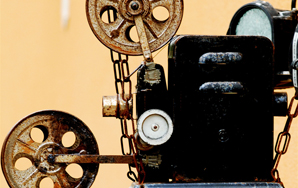My Life With A Robot
There is a robot dinosaur asleep in my closet, with its eyes closed and a fine sheen of dust on its ridged back. I’m not even lying. I can hardly look at it because it makes me so sad.

There is a robot dinosaur asleep in my closet, with its eyes closed and a fine sheen of dust on its ridged back. I’m not even lying. I can hardly look at it because it makes me so sad.
About three or four years ago, I was doing a lot of work on designed intelligence, like, I was reading and writing a lot about how the work of programmers and digital architects could create lifelike interactions. I’m not exactly talking about ‘artificial intelligence,’ because when people use that term they generally mean synthetic technologies that behave in realistic ways. People talk about ‘AI’ like someday we’re going to get to a future when computers have feelings or people marry robots that are indistinguishable from real people, or even like computers are going to get really smart and take over the world or something. Bleak Blade Runner AI futures. Bubblegum Crisis. Stuff like that.
No, I mean, when I was getting interested in designed interactions, I was looking closely at what it was about, say, vacant-eyed video game sprites that made people fall in love with them when we were kids. Like, when I was young I was really interested in this 16-bit purple dinosaur princess wearing a tiara. I’ve heard people who don’t even play games today tell me they still remember the impact of only one still image on some chunky old screen, because it was a certain context, the right image at the right time.
The type of ‘intelligence’ I’m talking about is the kind that doesn’t imagine artificiality as some conveyance to equality with human beings, but that sort of recognizes that human beings are capable of creating a sort of ‘life’ that isn’t alive, like… okay, picture the particular pathos of the wax-faced animatronics in old Disney. They were abstract humans, clacking their formless jaws and creaking as they bent stiffly at the waist, singing tinny. No one would ever be fooled into thinking they’re alive, but think about the concept of looking into their glassy, sightless eyes. Think of them on the dimmed set pieces after all the families and kids have gone home and their friendly ballads, piped through speakers, are silenced.
I mean, really think about them, the poor things. They were new once, the coloring in their face meticulously painted on by some devoted hand. They were exciting attractions for something called Tomorrowland, the theme park ‘vision of tomorrow’ that was inspiring when new and then quaint, strangely sad, with age. How innocent those dreams of the future were. I seem to remember a robot-man dressed like a barbershop singer, with cheery red-and-white pinstripes and a jaunty mustache. Now is the time, I think the song went as I rode as a child through that merry idyll of a future America. Now is the best time of your life, the robot-man was singing and clacking. I don’t actually think those animatronics are there any longer. I feel such a pang for them, a comingling of rue and relief and guilt.
It’s nothing like I’d feel for a dead human, but it’s the sort of sentiment that forecasts life of another kind. We see eyes, mouth, handmade cuteness in robot toys, but we also see the enduring spirit of human imagination, the ambivalent, tight-knotted hope that we can engineer ourselves some companions. Designed intelligence is a direct expression of mankind’s inherent fear of ending up alone, our mistrust of fallible humans. I remember the mall at Christmas, and outside the toy store the pen of little robo-terriers, gears buzzing as they yap-yap-yapped and did those little flips. I remember I would always find one that had fallen on its side, its stubby legs of fur-wrapped plastic still marching rhythmically upon empty air, and I would always feel compelled to right it.
So I wrote about the digitized blinks of video game princesses and the bleak, surreal experience of interacting with “intelligent” instant message bots or chat clients online. Then a handful of years ago a toy company announced it would manufacture an animatronic dinosaur toy called ‘Pleo’. It promised Pleo could react to the light and sounds in its environment and ‘learn.’ I looked at some websites about Pleo and learned that if you hold Pleo upside down by his tail, he flails and exhibits distress. I was seized with instant fascination and compassion. I was nauseated with it. I wrote to the manufacturer, Ugobe, explained I am a gaming and technology journalist, and asked if I could borrow a ‘Pleo unit’ for a week and write about it.
I wrote something like a neutral product review that I can’t find now. The fact is I couldn’t articulate it then, the collision of adoration and discomfort I felt toward something that was alive enough to make me care, yet not alive enough to make me fully invest in it. And being something of a prototype toy, at least at the time, Pleo didn’t live long.
The life of his batteries, which required constant recharging, took an immediate nosedive. He would haltingly lift his little green dino head, eyes only half-open. Then he developed a strange condition in which he bent his neck to one side and then did not unbend it, a horrifying paralysis given that he felt so lifelike, his machinery parts feeling cartilaginous and hard under the fleshlike rippled rubber that comprised his skin. Most horribly, the skin of his nape wore, a little slit opening therein, so that I could see what looked like the metal scaffold of his body. I don’t know, because I could no sooner look close than I could look at a wound.
I still have the deficient, forever-asleep Pleo. At least he had lay down before I shut him off for the very last time, so that his bent neck looks only like he’s curled in natural rest. I think I shut his eyes with my own fingers, like one does with a human corpse.
He is useless, but I can’t bring myself to get rid of him, or even to have handled him roughly when I moved from one apartment to another. He lies on a shelf in a storage closet. I feel horrendously guilty – and not just because the company never asked me to return Pleo, and so I never tried. Because I feel like there’s something I could have done to prolong his ‘life’, like there’s something I could be doing for him now. And I feel silly, because it’s just a toy dinosaur and I’m an adult and I feel guilty for feeling silly. Like if I had gone to Disney more maybe the barbershop singer would still be there, singing his tune. I didn’t say anything in defense of these things people made and loved and then forgot.
Sometimes if I have people over and I have to open the closet for something else and someone catches a glimpse of him they always say, like, “oh my gosh, what is that,” and I say, “it’s a robot dinosaur, it’s broken,” because I just don’t want to talk about it and I shut the door really quickly. Now is the best time of our lives.![]()




